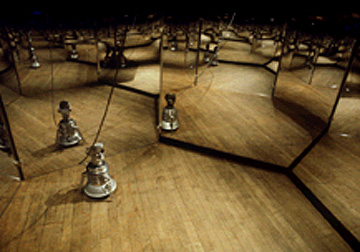click images for larger versions
What is there to say? Does it make a difference if you are not seen, but rather a projection that sees and speaks and hears in your place? Is the 'I' saying 'Me' to 'It-You' (or its reflection)? Is it that the one who stands in your place is not free to go where they wish, or that even as you move them "freely" in their mirrored infinity theater that there are borders? Is it that they can see their wires but know not where they lead? Is it that in the space of the art exhibition there is also a meeting of those who see but are not seen and those who learn to play the game with their projections?
I learned in 1991 that the Mbone had been invented, making it possible to transmit real-time video and audio over the Internet. A networked metaphor would seem to offer a new genre of complexity – were it not for the fact that here and there, I and you and mine and yours have always been bones in the skeleton of our sense-selves and in our ideologies.
In one exhibition there is a constructed labyrinth. The walls are mirrored. Inside of this space, there are three robot-puppet ventriloquist dolls. In three other locations are darkened spaces, each with a seat, a small table upon which sits a controller-interface (an attaché case containing a joystick and a microphone), and on the facing wall a projected video image showing the robot's vision.
Each robot has a video camera for sight and microphones for hearing. Each robot is connected remotely to one of the other spaces (anywhere on the Internet Mbone). A viewer can maneuver the robot with a joystick while their voice is spoken back through the doll as their own. Three remote participants can therefore communicate inside the mirrored space through their dolls.
Participants are inevitably pressed to regard these questions: "Which one is me?" "Am I talking to you or to myself?" "Am I moving towards or away from the mirror?" "What are the limits of this space?" "Am I having any effect on what is happening?" –kf 1995
exhibition history:
Mary Anthony Galleries, New York, "Synesthesia", March–May 1995
Interactive Media Festival, Los Angeles, June 1995
ACE Gallery, Los Angeles, 2005–2006



